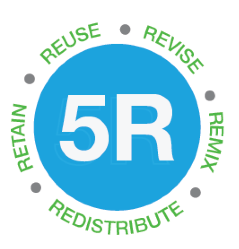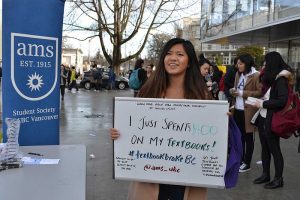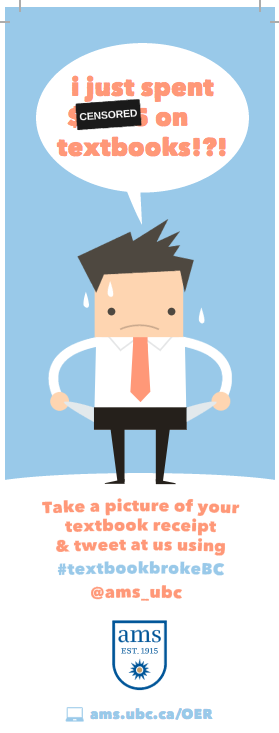For Student Societies and Student Leaders
Student-Facing Advocacy
#textbookbroke
One of the best ways to mobilize student voices in support of open education is to appeal to the fact that students spend too much money on textbooks each term. You can demonstrate wide student support and inform students about the high cost of textbooks through a campaign like #textbookbroke, a social media campaign that can be adapted to any institution.
This campaign involves asking students to take a photo showing how much they spent on their textbooks, then posting the photo on social media along with the hashtag #textbookbroke (or a variation of this hashtag, like #textbookbrokeBC). The photo could be taken as the student leaves their campus bookstore, or an image of their bookstore receipt could be posted online along with the hashtag.
The campaign raises awareness of the existence of open textbooks and OER, and starts the conversation surrounding the costs of educational resources and how they are used in the classroom. More information about the #textbookbroke campaign can be found in Appendix C of this toolkit.
Engage students in programming during events like Open Education Week.
Many universities hold OER-themed programming, like panel discussions or workshops, during Open Education Week or similar annual events. These are opportunities to involve students in programming that is normally only appealing to faculty and staff, ensuring that student opinions are heard. You might try to get students involved in event planning processes, ensure students participate in panels or presentations, or advertise events to your study body. This allows information to be shared with students that are involved, and student-centric messaging to be shared with those on your campus involved in OER promotion.
Ensure that your own resources and information is openly licensed and share with other student groups and societies.
It is great to talk the talk, but make sure to walk the walk as well. The open education community is very supportive, and we can only be successful if we work together and make our resources open. You can use open licenses for resources your student society creates and adapts, to ensure that you are supporting other student groups and societies in starting their own OER initiatives. An easy way to do this is using the Creative Commons Choose a License feature. Make sure to look for existing resources you could adapt before creating your own.
Faculty-Facing Advocacy
Make faculty-facing advocacy a priority.
Instructors and faculty members are the ones who choose the educational resources they will be using in the classroom, so advocacy directed at faculty may be the best means for change. Having a good understanding of the pedagogical benefits of open and how to adopt and create OERs makes students able to provide instructors with the right information to support them in adopting OER and open practices.
Create opportunities for faculty engagement and professional development.
Many faculty have either never heard of OER or, even if they have, don’t know how to start using it in their courses. University teaching and learning centres and libraries often offer regular professional development workshops or events centered around themes related to improving teaching. Student leaders can encourage more content related to open education to be injected into these, and can join in their delivery to talk about what is important from the student perspective.
Encourage your institution to offer grants to faculty willing to redesign courses with OER.
Providing monetary support for faculty members willing to adopt OER as their primary course materials can incentivize greater adoption, and also shows that faculty thinking about adoption have institutional support behind them. For example, at Simon Fraser University (SFU) the Vice-President Academic Office made available a number of OER Grants valued at $5,000 which aim to support the adoption of OER in SFU courses. These are restricted to covering the costs of support for the faculty member through research assistants, persons with specific expertise, support for data collection and analysis, and travel for the dissemination of findings. Institutions should ensure that the focus includes both resources like textbooks but also ancillary materials that instructors often find as part of publishers’ packages.
Advocate for your library to make OER easily accessible in their catalogue.
Faculty are more likely to trust resources if their quality is assured by librarian approval. If your library can make resources like open textbooks available to find in their online, searchable databases, faculty will be more likely to adopt them. The UBC Library, for example, has an online research guide about open education, which includes a page about finding open textbooks in the UBC collections.
Encourage creation and adoption of OER through faculty promotion and tenure processes.
Investigate the processes for faculty promotion and tenure at your institution, and determine who is responsible for setting guidelines. Ask them to consider the use of open educational practices as one (among many) of the ways faculty can demonstrate commitments to quality teaching during the promotion and tenure process. Showing that you have faculty members who support this may help, and you might consider garnering this support by connecting with your institution’s union or association of faculty.
For Students more Broadly
There are many low-barrier ways that individual students can get involved in the open education movement, and student societies can encourage these activities within their student body.
Talk to your professors or instructors about open educational resources.
The final say about what resources will be used in a course usually lies with faculty, to whom students have unique, direct access. Some ways of doing this include:
- Show faculty students care about this issue by sharing your thoughts on high textbook costs or showing them you appreciate it when they use cheap or free alternatives. One easy way to do this is through anonymous midterm or end of term course evaluations that take place at many institutions.
- Tell faculty about open education that you think may be interested. If you know of any examples of OER that would be useful in a course you have taken, tell the instructor about it. You can also refer them to resources or OER repositories (see below), or share stories of other faculty adopting OER at your institution.
Create open content yourself.
Students can choose to publish their own work under an open license as well:
- See this open publishing guide developed by SPARC’s Right to Research Coalition for some suggestions and guidelines.
- Students can use platforms like flickr to upload photos and images they have created under open licenses, including content they may have created as part of their courses.
- Many institutions also have local opportunities for students to publish their work, often in student-led, open access journals. Students can seek out these opportunities, and student leaders can help promote them widely.
Pass this resource on to your student society.
As a member of your institution’s scholarly community you can have a lot of influence over the way in which you create content and experience teaching and learning. However, you can have much more support by working with the student society that represents you to advocate for OER, and by doing so you can ensure that it is a priority for more students. This resource is meant for you as a student, and for groups and societies, so make sure to pass it along, or adopt it for your own context.



